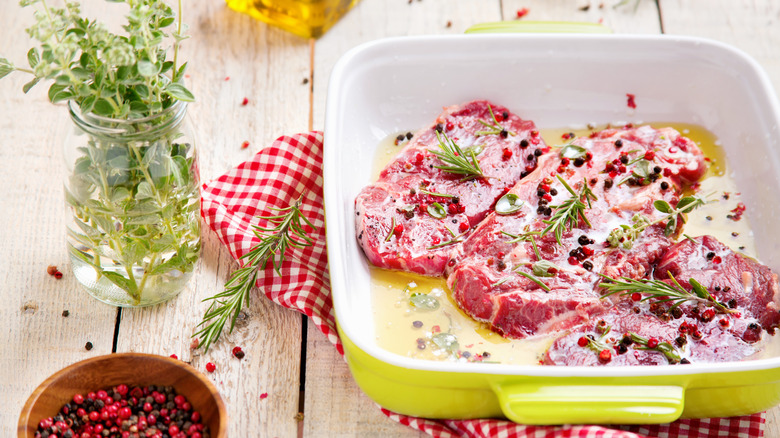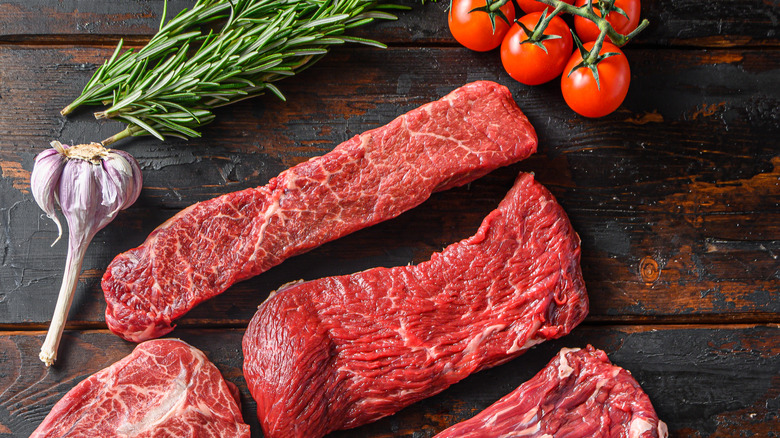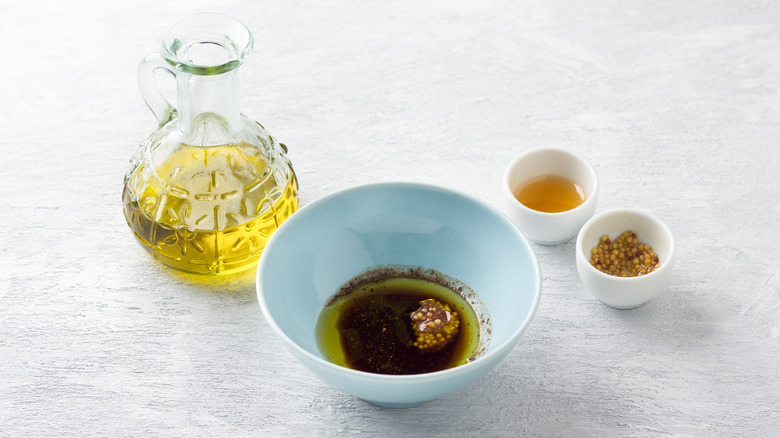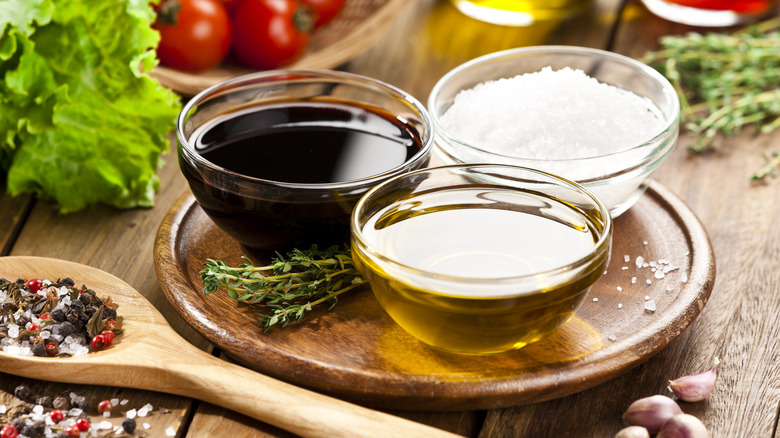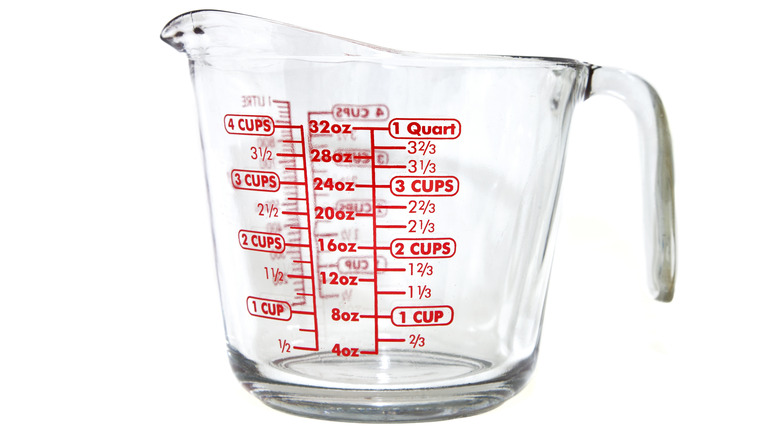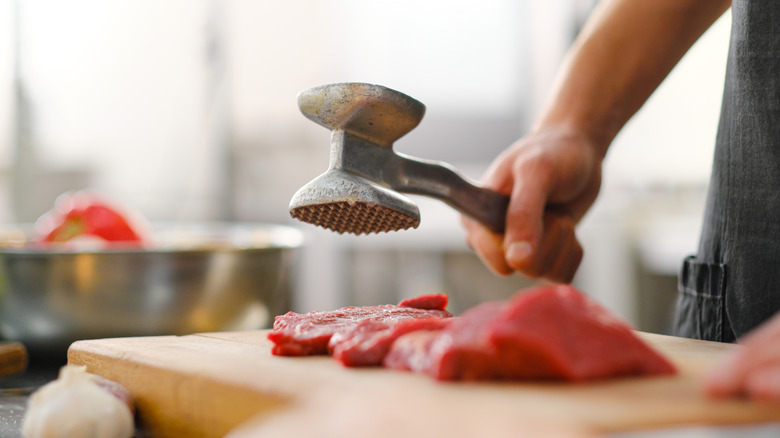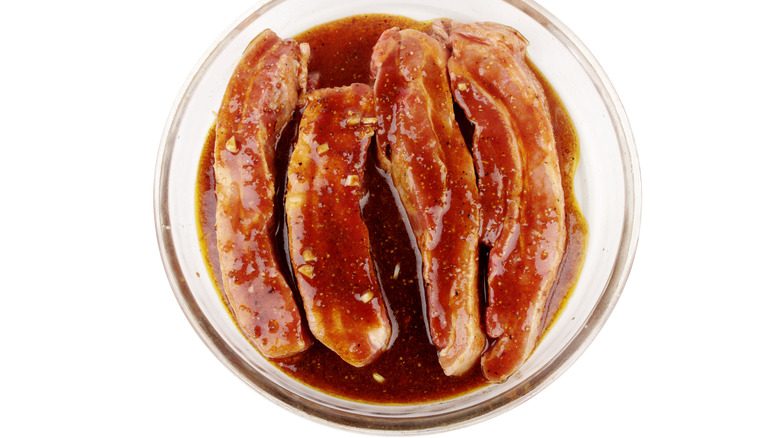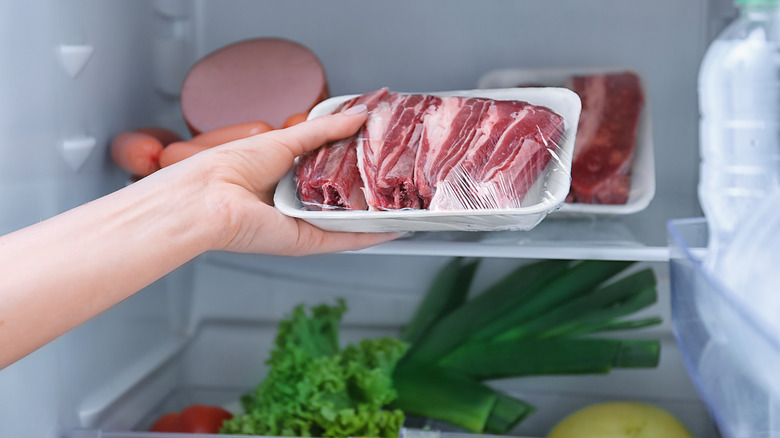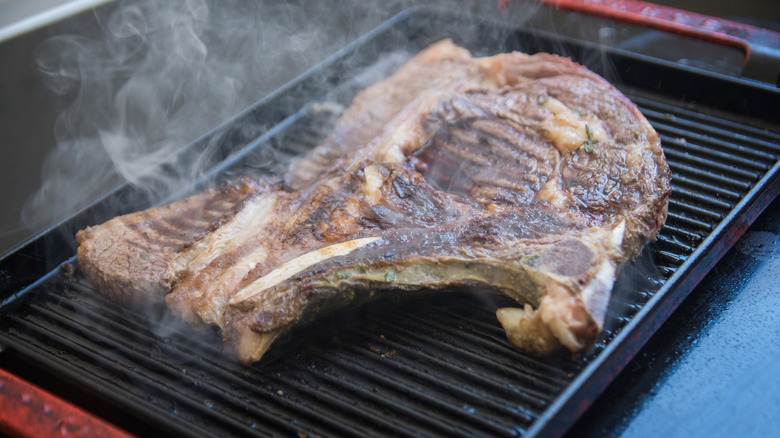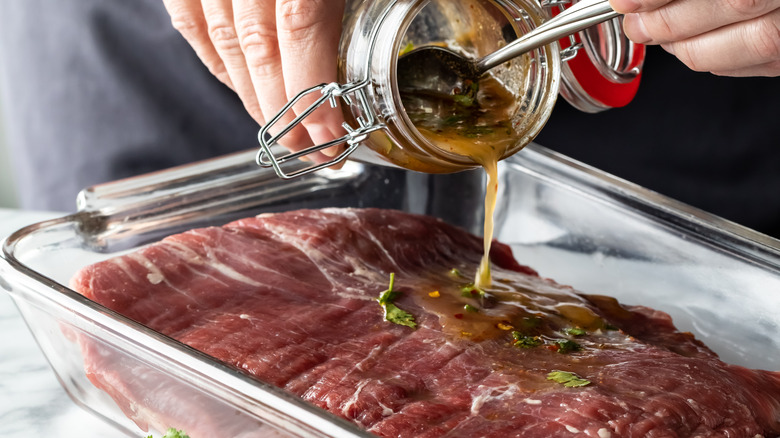12 Tips You Need To Marinate And Tenderize A Cut Of Steak
It seems like a no-brainer that soaking a steak in a flavorful liquid makes meat taste better. Almost as easy to grasp is that under the right conditions, soaking meat in flavored liquid also tenderizes a tough steak.
At its simplest, marinating steaks overnight covered in a bottle of store-bought Italian salad dressing gets the job done, but is it really the best way to do things? There are plenty of misconceptions and misinformation about marinating, and we are here to help clear those up and fine-tune your techniques. Marinating the proper cut of steak with the right ingredients in the correct amounts for the right amount of time can move your style from good to great or help you put your best foot forward if you're just starting out. We'll take a look at myths, legends, and science to arrive at the best place for you and your steaks.
Pick the right cut
We all want to coax the most flavor out of our grilled foods; marination is a great way to accomplish that. However, as all cuts are not created equal in the tenderness and flavor departments, not all cuts are good candidates for marination or manual tenderizing — a fancy way of saying pounding with a mallet or other tenderizing tool.
So, what steaks should you marinate, and which should you not? The price tag will usually tell you. Less expensive cuts, like flank, skirt, hanger, or steaks from the chuck, sirloin, or round, benefit the most from marinating. Tenderness and flavor commonly drive price, and these lower-priced steaks usually have more fibrous muscles, connective tissue, intramuscular fat, and less depth of flavor. Because of all, or any, of these, marinating them makes sense. Taking it a step further, marinating them in conjunction with manual tenderization sometimes yields the best results.
A more expensive steak, like a fillet, ribeye, or New York strip, is naturally tender, although steaks from the nerve end of the N.Y. strip benefit from some manual tenderizing. These steaks also tend to have more depth of flavor, which potentially gets overridden by the aggressive flavors of a marinade, and you've put time and money into the process without seeing much benefit.
The right marinade ingredients are essential
The easiest way to marinate is to buy something pre-made off the shelf at the grocery store, (even salad dressing) but those might not get you where you want to go in terms of flavor. The next easiest way is to build your own marinade. If that sounds intimidating or expensive, you can build a pretty serviceable marinade from items you already have in your kitchen.
Marinades have three elements: acid, fat, and flavoring. Acid works on muscle and connective tissue and takes many forms, from the obvious to the not-so-blatant. Vinegar, wine, and citrus are frequent contributors, each bringing its distinct flavor to the table. Consider their base flavors and how they complement or contrast the other ingredients. Red and white wines contribute acid and can contribute clean brightness or deep, tannin-rich tones.
Fat carries, uh, fat-soluble compounds to your meat and, like acid, can take many forms. Cooking oils, such as olive, walnut, sesame, or a neutral oil like canola or grapeseed, are all viable, depending on your desired flavor profile. Animal fats like bacon, beef, chicken, or duck can also serve that role.
Layering your flavors with the three marinade elements results in more depth and complexity; the flavoring elements are where you get to have fun. Sweet elements like honey (but avoid sugar, as it burns and becomes bitter at a low temperature), savory flavors from herbs and spices, and heat from chiles or cayenne pepper are all good possibilities.
Balance your marinade ingredients
Now that we've discussed what goes into a marinade, it's time to talk about how to use them wisely. If you're scratching your head about that, let us explain. Finding the balance of ingredients in your marinade is just as important as what the ingredients are.
Acid is the first thing to worry about because, unchecked, it can give you a puckering level of flavor. To keep this in line, approach a marinade like making a vinaigrette; when using a sharp vinegar, like red or white wine, add one part acid to three parts fat. You can change up the proportions for a milder vinegar or citrus to a point approaching half and half. Even with keeping the proportions in check, you'll need to mellow the astringent flavor of the acid, and the best way to accomplish that is salt, the unspoken fourth ingredient of a marinade.
Salt is the byproduct of an acid combining with a base and easily disassociates. Disassociation is everything here, as it will help a weak acid — like those foods we consider acidic — disassociate, mellowing the sour bite that we perceive from vinegar, lemon juice, etc. Salt is also the catalyst for osmosis, which causes a marinade to absorb into meat. If the science is too much, remember "one part acid to three parts oil" and salt your marinade. Even if you don't salt it directly, you can accomplish that via soy sauce, fish sauce, or similar salty ingredients.
Consider buttermilk and pickle brine
It's a good marinade for fried chicken, so maybe it will work on steaks? Let's take what we already know about marinating; we need acid, fat, flavor, and salt to make our best marinade. How do buttermilk and pickle brine fit into that picture?
Buttermilk is typically a lacto-fermented product, started from milk with the addition of a starter. After fermentation, the resulting buttermilk becomes tart from lactic and diacetyl acids created as a byproduct from the culture. It's mildly acidic (4.4 to 4.8 pH) and contains between 6% to 20% milk fat, which satisfies the fat requirement in a marinade.
We can then ratchet up the acid with pickle brine. Remember speaking of "found" acid components earlier? Pickle juice is a good one. It's good because of the acid and contains salt, sugar, and assorted herbs and spices that went into flavoring the pickles. Use the 1-to-3 ratio of acid to fat or one part pickle brine to three parts buttermilk.
Marinate for the proper amount of time
Modern convention calls for marinating meat 24 hours, or overnight, at the least. But when using an acidic marinade, more time marinating does not equal better steak.
The acidic elements of a marinade work by denaturing the long proteins in meat, literally unwinding them and making them tender. However, allowing the acid to work on the meat for too long will unwind the proteins to a point where the meat becomes mushy and dry. Some sources point to only marinating for 15 to 20 minutes, but we like to give the salt in the marinade time to work its osmosis magic and draw salt and moisture in and prefer to let the meat bathe for one to two hours.
Another consideration of long marinade time is safety. We'll talk more about that later, but suffice it to say that leaving your meat with large amounts of exposed surface area for extended periods speeds microbial reproduction, even in the refrigerator.
Use the right amount of marinade
According to the Utah State University Extension, conventions calculate one ½ cup of marinade per pound of meat. But that never seemed quite right. We've played with this idea for years and ultimately considered science in arriving at our conclusion: marination, a combined process of osmosis, enzymatic reaction, and protein denaturing, happens at the cellular level, and cells are tiny. So why would you need a ½ cup of marinade per pound of meat to make this happen?
It turns out that you don't. Cooks we've trained have been skeptical, as have students we've taught. We like to use the smallest bowl possible that the food will fit into, just to illustrate that we don't need room for excess marinade. We then add the smallest necessary amount of ingredients and let the food sit for an hour. Many question the method, but they're converted when we feed them the results. So, considering that more than a thin coating is money and food down the drain.
Poke it or pound it
For particularly tough cuts of meat, such as some from the chuck or sirloin, pounding might be in order. The goal of pounding a piece of meat isn't to obliterate it; you're interrupting and spreading the muscle fibers to accomplish the same thing as the acid denaturing the proteins — only much faster. You start at the middle of the steak and work outward, giving medium-firm whacks along the way. This technique prevents thin middle and thick edges, or vice versa.
Another process is to use a meat mallet with sharp spikes or a needle tenderizer to poke holes in the steak. The needles interrupt the muscle fibers to tenderize the meat and provide a pathway for the marinade to reach the steak's interior instead of just the outside. Lacking either of these tools, a sharp fork or the tip of a small knife can provide multiple small, shallow holes to accomplish the same thing. You can use this process on any meat you're going to marinade, regardless of its toughness, without adversely affecting the steak, as long as you don't get too exuberant with your poking.
Contain your marination
This idea applies to several levels. First and most obvious, you want to keep your meat in the marinade. While plastic bags seem useful for this, place them on a plate or pan to protect them from punctures, and don't set anything on top of the bag. Protecting the bag not only keeps the marinade on your meat but keeps it from running or dripping in your refrigerator.
A metal bowl might seem a good option, as they're sturdy and usually non-porous, so they don't present a puncture danger or absorb odors or flavors. But don't marinate in a metal bowl unless you're sure your bowl is constructed of nothing but stainless steel, and cheap bowls usually aren't. Why the fuss?
If you're using an acidic marinade and a cheap bowl, there's an excellent chance the acid could react with a soft metal in the bowl, which would then leach into your meat. While we're on the subject, don't use an aluminum or copper pot for marinating, as these are very soft metals. Ensure that your vessel says "non-reactive" or select a different container. Our go-to marination container when cooking at home is a glass baking dish that's strong and assuredly non-reactive.
Keep it cold
If it's best to let your steak warm to room temperature before cooking, marinating at room temperature is equally good, right? Since warming the steak "relaxes" the meat and opens the protein, marinating at room temperature looks good on paper. But it's not a good idea.
There are three fundamental issues with warm marinating. First, temperatures between 40 and 140 degrees Fahrenheit are prime environments for bacterial growth, the U.S. Department of Agriculture (USDA) calls "The Danger Zone." Next is that laying meat out to marinate versus leaving it in the package increases the surface area bacteria can grow on. The third is that initially, bacteria only grow on the surface of your food, but if you've needled your meat, you've created a path for pathogen growth inside the food, compounded by another factor. As you're counting on acid to uncoil proteins, bacteria, too, will break down connective tissue, allowing another pathway into meat. Your safest bet is to marinate your meat in the refrigerator, which keeps the meat below the Danger Zone. But if you absolutely must marinate at room temperature, the USDA strongly recommends limiting the marinating time to two hours or less to keep bacterial growth in check.
Play it safe
Food safety should always be a top priority when marinating. We've already discussed storing your meat in a container that won't leak or react with acid. Leak prevention has another facet: keeping your meat juices from contacting other food in your refrigerator, which can cause cross-contamination. Cross-contamination occurs when bacteria from one food, often unintentionally, spread to another food, according to the USDA. Another way to prevent cross-contamination is to store your raw meats below any cooked foods or those intended for eating raw, like vegetables you might use in a salad.
As always, wash your hands frequently, especially after handling raw meats, and clean your cutting boards and knives immediately after contacting raw meat. Finally, if you've made extra marinade that you think might be nice to finish or baste for your cooked meat with, stop right now.
Your marinade is full of bacteria that multiplied while you let the meat sit in the refrigerator. While it could be used as a baste early in the cooking process, knowing exactly how long it needs to cook or how hot it is to kill the bacteria is a foolish gamble. If you must repurpose the marinade, boiling it for five minutes to ensure safety is a must.
Drain/dry your meat
After crafting your marinade and patiently waiting for your steak to get its spa treatment, it's time to grill. But after putting in the extra time and work, wouldn't it be a shame if your steak came off the heat grey, pallid, and flabby? To be fair, some cuisines don't value caramelized grilled meat as much as others, so if that's not a priority to you, you can skip this step.
But if you're looking for that textural experience from your grilled meat, you'll have to do something about the excess liquid from your marinade coating your meat. That's because water interferes with the Maillard reaction, which produces browned meat. Since Maillard browning occurs above the boiling point of water, a large amount of heat energy goes into boiling off any surface liquid during cooking. That energy doesn't go into browning the meat. The simple answer? Drain your meat well before cooking it. You can also take the extra step of blotting it with a paper towel to remove residual moisture. For the extremists, you can drain your meat, place it on a cooling rack on a baking sheet, and let it dry in the refrigerator for an hour or so to ensure no lingering water gets in the way.
Consider marinating your steak after it's grilled
Sometimes we get stuck doing things because "that's the way they're done." We've just laid out a long list of concepts to consider, treating your steak before cooking, because that's how it's done. But does it have to be? We know what you might be thinking: After reading this long list of "how to's," we bring out this idea of trashing most of them and daring you to marinate your meat after it's cooked. Relax; you can still marinate your meat pre-grilling. It's not incorrect to do so, we're just presenting another option.
Letting your meat rest after it comes off the grill is always recommended. Now, consider resting your meat in a flavorful marinade. It's not as ridiculous as it seems. En escabèche is a common cooking technique in Mediterranean, Central American, and other cuisines. You cook your meat, fish, or vegetables and then preserve them in an acidic sauce when they're done. Except for the preservation part, this is precisely what post-cooking marinating does. The heat from the cooked steak helps the marinade absorb while coating the exterior. After the meat rests, gently heat the marinade and meat together before serving. You've marinated and sauced your food in one step, without the food safety concerns.
